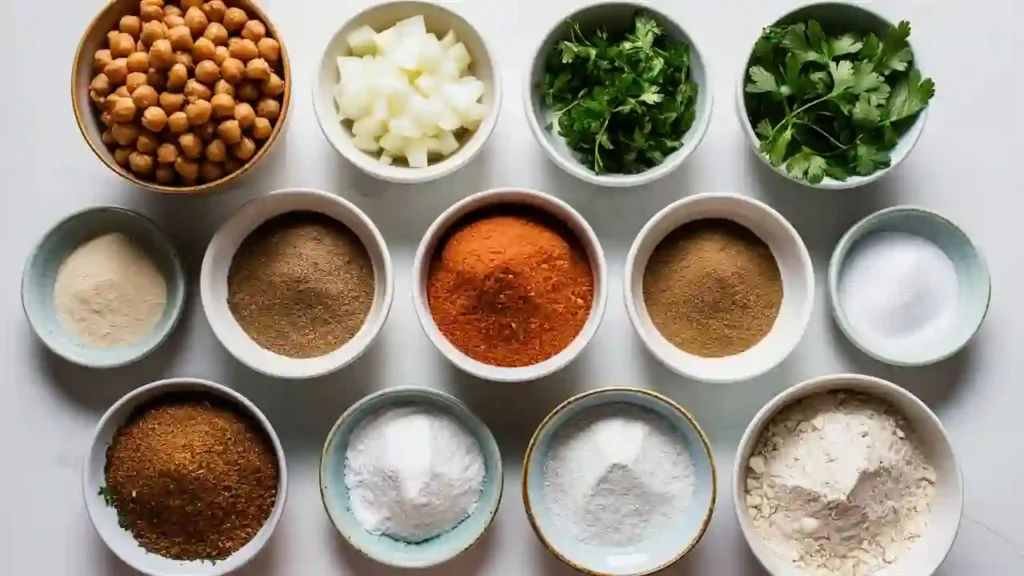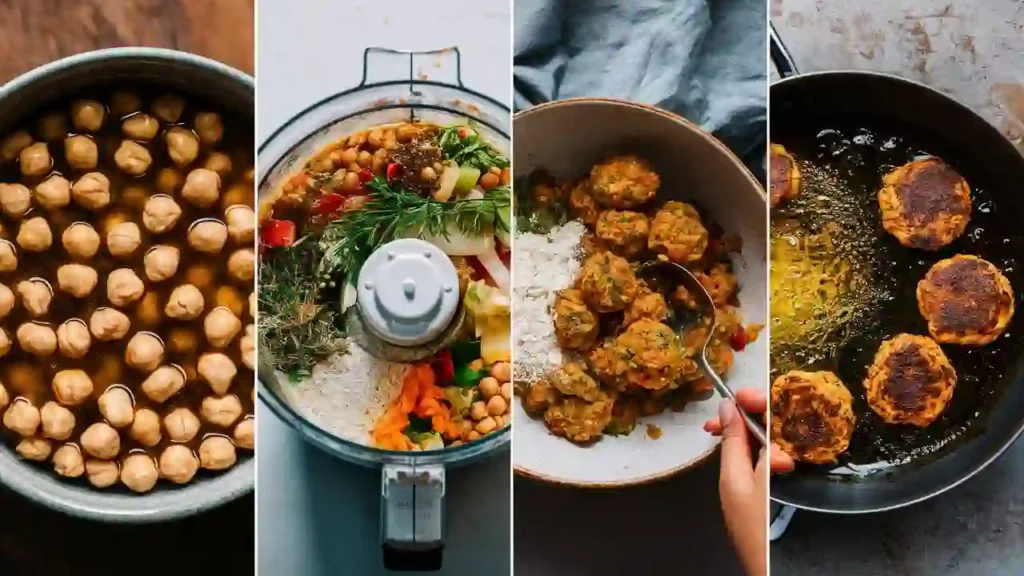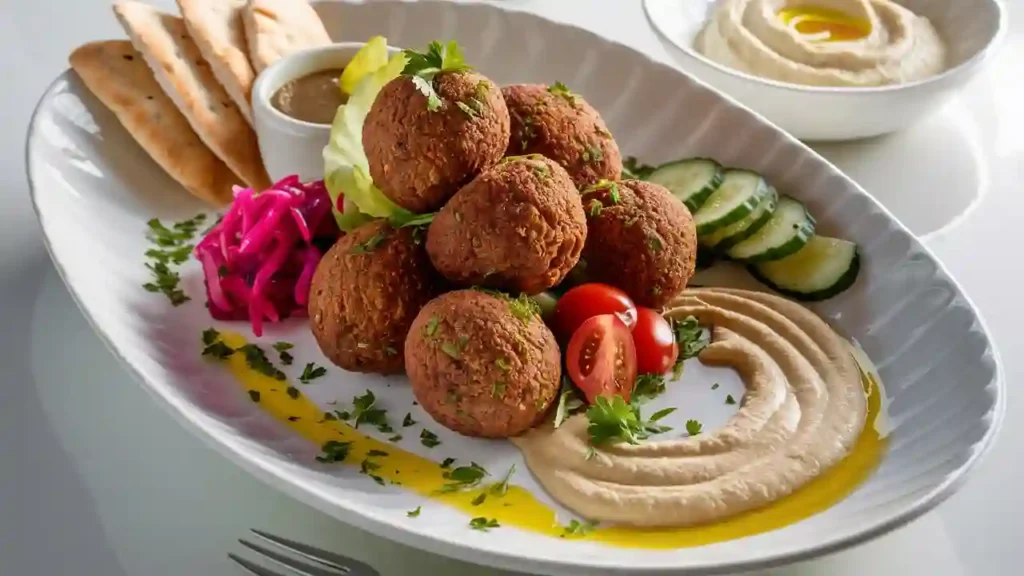Last Updated on May 18, 2025 by Lucas
Craving something crispy, flavorful, and ready in just 35 minutes? This falafel recipe is your go-to for a quick vegetarian meal that’s bursting with Middle Eastern spices. Whether you’re stuffing them into pita wraps or serving them over a vibrant salad, these chickpea patties deliver bold flavor and plant-based protein in every bite. I’ll show you how to make this homemade falafel with simple ingredients and minimal fuss—perfect for busy nights or weekend meal prep.
Key Benefits
This falafel recipe offers a quick, flavorful, and nutritious option for lunch or dinner. It’s a reliable, meatless staple perfect for your weekly meals.
Quick and Easy – Ideal for Busy Weeknights
When time is tight, you need recipes that come together fast without sacrificing flavor. This falafel recipe requires only 35 minutes from start to finish, using pantry staples and minimal prep.
- No overnight soaking required—use canned chickpeas for quicker prep.
- All ingredients go straight into a food processor—no fancy techniques.
- Perfect for weeknights when you want something warm, filling, and homemade.
Transition Tip: Instead of takeout, this recipe gives you the comfort of homemade with none of the waiting.
Packed with Plant-Based Protein
Looking for a meatless meal that actually satisfies? Falafel, made from chickpeas, is naturally rich in plant-based protein and fiber, making it both filling and nutrient-dense. Chickpeas (garbanzo beans) also provide:
- Essential vitamins like B6 and folate
- High fiber content that supports digestion
- Has a low glycemic index, which supports stable blood sugar levels
[Harvard School of Public Health]
Whether you’re following a vegetarian, vegan, or flexitarian lifestyle, this falafel recipe fits beautifully into your dietary goals.

Crispy Outside, Tender Inside – No Compromise on Flavor
Texture makes all the difference. This recipe ensures your falafel turns out crispy on the outside and soft and tender in the center, thanks to key techniques:
- A touch of baking powder ensures a light, fluffy interior
- Frying in a light layer of olive oil or using an air fryer yields golden crispness
- Fresh herbs like parsley and cilantro brighten the flavor profile
Each bite is infused with warm Middle Eastern spices such as cumin and coriander, capturing the essence of a truly authentic falafel recipe.
Versatile – Great for Meal Prep or Wraps
Falafel is the ultimate multitasker in your kitchen. Make a batch today and use it throughout the week in creative, satisfying ways:
- Tuck them into pita wraps with veggies and tahini
- Top a Mediterranean grain bowl for a protein-packed lunch
- Serve over a fresh salad with garlic yogurt sauce
- Freeze extras for quick lunches or weeknight dinners
This falafel recipe is naturally adaptable, making it ideal for meal prep, work lunches, and even family-style dinners.
Ingredients
Whether you’re making falafel for the first time or refining your go-to version, having the right ingredients and tools can make a world of difference. This section breaks down what you need for authentic flavor, clever add-ins, dietary swaps, and foolproof prep.
Core Ingredients for Authentic Flavor
To create falafel that stays true to its Middle Eastern roots, you’ll want to use a simple combination of herbs, spices, and pantry staples. These ingredients form the flavorful foundation of your falafel recipe:
| Ingredient | Purpose |
| Chickpeas (cooked) | Main base, rich in protein and texture |
| Fresh parsley | Adds brightness and fresh herb flavor |
| Garlic | Deepens the savory taste |
| Onion (yellow or red) | Enhances flavor with subtle sweetness |
| Cumin | Earthy spice, essential for traditional taste |
| Coriander | Balances out the cumin with citrusy notes |
| Salt & black pepper | Brings all the flavors together |
| Baking powder | Gives the falafel a light, airy texture |
| Flour (or oat flour) | Helps bind the mixture |
Tip: Use canned chickpeas for convenience. Be sure to drain and pat them dry to avoid a soggy mixture.

Optional Add-Ins for Extra Kick
Depending on your flavor preference, you can elevate your falafel recipe with bold, aromatic spices and extras. These ingredients are optional, but they can take your dish from basic to unforgettable.
- Paprika or smoked paprika: Adds color and depth
- Cayenne pepper: For a gentle heat (adjust to taste)
- Lemon zest: Introduces a subtle citrus lift
- Sesame seeds: Fold into the mix or sprinkle on top before frying
- Mint or cilantro: Swap or combine with parsley for a twist
These traditional falafel spices not only boost flavor but also let you tailor the dish to your palate.
Gluten-Free or Vegan Substitutions
This falafel recipe is naturally plant-based, and with a few tweaks, it can easily be made gluten-free too. Here’s how you can adjust it to suit specific dietary needs:
- Gluten-free falafel option: Replace regular flour with chickpea flour or oat flour
- Oil-free version: Bake or air-fry the falafel instead of pan-frying
- Egg-free binder: No eggs needed—chickpeas and flour hold everything together
These swaps ensure your vegan falafel recipe stays inclusive without compromising texture or taste.
Tools to Make It Easier
Making falafel at home is much easier with the right kitchen tools. These items will help you mix, shape, and cook your falafel efficiently:
- Food processor: Quickly blends ingredients to the right consistency
- Mixing bowl: For combining and resting the mixture
- Cookie scoop or spoon: Keeps portions uniform for even cooking
- Skillet or air fryer: Choose your preferred method—crispy either way
Helpful Note: If using an air fryer, lightly brush the falafel with oil to enhance browning without deep-frying.
Instructions
Making falafel at home can feel intimidating at first, but once you go through the process, you’ll see it’s easier than you think. With a few tools, fresh ingredients, and these simple steps, you’ll be enjoying crispy falafel in no time. Let’s break it down so you can cook confidently.
Blend the Ingredients to a Perfect Texture
To begin your falafel recipe, start by processing the ingredients to get a coarse but moldable texture. Here’s how to do it right:
- Prep Your Ingredients:
Drain the chickpeas well and pat them dry using paper towels. Chop onions, garlic, and herbs. - Use a Food Processor:
Add the chickpeas, parsley, garlic, onion, cumin, coriander, salt, and black pepper to the bowl. Pulse until the mixture resembles damp sand. - Add the Binders:
Sprinkle in flour (or breadcrumbs) and baking powder. This helps bind the mix and prevents crumbling later. - Check the Texture:
The mixture should hold its shape when gently pressed between your fingers. Don’t over-blend—aim for a coarse texture, not a smooth paste like hummus.
Tip: Let the mixture rest for 20–30 minutes in the fridge. It firms up and is easier to shape.
Shape and Cook – Pan Fry, Air Fry, or Bake
Once the mixture is ready, you can shape and cook the falafel in a way that suits your kitchen and dietary goals.
- Shape the Falafel Balls or Patties:
Use a spoon or small scoop to portion, then roll them into small balls or flatten slightly into patties. - Pan Fry for Classic Texture:
Heat oil in a skillet over medium heat. Fry falafel until golden brown, 3–4 minutes per side. - Air Fry for Less Oil:
Preheat the air fryer. Lightly oil each falafel. Air fry at 375°F (190°C) for 10–12 minutes, flipping halfway. - Bake for a Healthier Option:
Arrange falafel on a lined baking sheet. Brush with oil. Bake at 400°F (200°C) for 25 minutes, flipping once.
No matter which method you choose, the falafel should be crispy on the outside and soft inside.

How to Keep Your Falafel from Falling Apart
This is one of the most common questions about any falafel recipe. Fortunately, there are a few tricks that work every time:
- Don’t Use Cooked Chickpeas from Scratch:
They’re often too soft. Use canned chickpeas, but dry them thoroughly first. - Use Flour or Breadcrumbs:
These act as natural binders. Add gradually and stop when the mix holds together. - Add Baking Powder Last:
It creates air pockets that keep the inside fluffy, but wait until just before cooking. - Rest the Mixture:
Even 20 minutes in the fridge can help. It gives the flour time to absorb excess moisture.
These tips make a big difference, especially when trying to achieve the best texture.
Quick Sauce Option – Garlic Tahini Dip
What’s a falafel recipe without a flavorful sauce? This garlic tahini dip is creamy, zesty, and comes together in under 5 minutes.
Ingredients:
- ¼ cup tahini
- 2 tablespoons lemon juice
- 1 garlic clove, minced
- 2–4 tablespoons cold water
- Salt to taste
Instructions:
- Mix tahini, lemon juice, and garlic in a bowl.
- Slowly add water until the sauce reaches your desired thickness.
- Add salt and stir until smooth.
Optional Add-ins: A touch of olive oil or chopped parsley adds extra flavor and color.
This step-by-step breakdown simplifies the falafel recipe into manageable parts. Each method is flexible, so you can tailor it to your kitchen tools or dietary needs. Ready to move to the next section: Pro Tips and Variations for expert-level upgrades and smart twists?
Pro Tips and Fun Variations
After mastering the basic falafel recipe, explore pro tips, storage tricks, and creative variations to boost flavor, texture, and convenience every time.
Make It Extra Crispy Every Time
Getting that perfect golden crust is easier than you think. With just a few adjustments, your falafel balls can turn out irresistibly crispy — without being greasy.
Here’s how you can do that:
- Chill the Mixture Before Shaping:
Cold mix is firmer. This leads to better structure during cooking. - Don’t Overcrowd the Pan or Basket:
Space allows the hot air or oil to circulate evenly, crisping all sides. - Use the Right Oil:
Choose oils with high smoke points. Light olive oil or avocado oil work well. - Pan Fry on Medium Heat:
If the heat is too high, the exterior will brown too quickly while the inside stays undercooked. Using moderate heat helps develop an even, crisp crust.
Quick Tip: For oven or air fryer versions, a light brush or spray of oil over each falafel helps mimic the deep-fried finish — minus the mess.
Flavor Variations You Can Try Today
Want to customize your falafel recipe without losing its authentic charm? Here are some quick add-ins that deliver bold, unique results:
| Flavor Booster | How It Enhances the Falafel |
| Coriander Seeds | Adds a citrusy, slightly peppery bite |
| Fresh Cilantro | Introduces brightness and herbal depth |
| Chili Flakes | Delivers heat — great for spice lovers |
| Smoked Paprika | Gives a warm, earthy smokiness |
| Sesame Seeds | Add a nutty crunch when mixed into the batter |
These additions are easy to mix into the main recipe. You don’t need to change the cooking method — just adjust seasoning as needed and taste the raw mix (before cooking) to balance flavors.
Make-Ahead & Freezing Tips
Falafel is one of the best recipes for meal prep. If you’re juggling a busy schedule, you’ll appreciate how well it stores. Here’s how to stay ahead:
Refrigerate Uncooked Falafel:
Wrap the shaped falafel in parchment and keep them in an airtight container. Use within 2 days for best results.
Freeze for Longer Storage:
Lay falafel balls on a tray. Freeze until solid. Then transfer to a freezer-safe bag. Label and date them.
Cook Straight from Frozen:
No need to thaw. Just add a few extra minutes to your cooking time. Whether frying, baking, or air frying, the texture holds up beautifully.
This strategy makes your falafel recipe more than a one-day dish — it becomes a reliable go-to for quick meals and snacks.
Air Fryer vs. Deep Fryer vs. Oven Baking
You might be wondering which cooking method is best for your falafel. Each one has pros, so here’s a breakdown to help you choose what fits your routine:
| Method | Texture | Oil Usage | Best For |
| Air Fryer | Crispy outside, soft inside | Minimal | Quick, healthier weekday meals |
| Deep Fryer | Extra crunchy, golden | High | Traditional, crowd-pleasing batches |
| Oven Baked | Firm, slightly dry | Low (brushed) | Meal prep, lighter diets |
Takeaway:
If you want the most authentic texture, go for frying. For a lighter version with less cleanup, the air fryer is your best friend. Baking works well too, especially when making larger batches.
By incorporating these pro tips and variations, your falafel recipe won’t just be good — it’ll be memorable. Play around with flavors, prep ahead for convenience, and match the cooking method to your needs. The result? Falafel that fits your life and satisfies every time.
Next: Learn how to serve your falafel for maximum flavor and appeal — from wraps to bowls and beyond.
Serving Suggestions & Delicious Pairings
Once your falafel is ready, elevate it with creative serving ideas—from wraps to bowls—using bold, flavorful pairings that make each meal complete.

Build the Ultimate Falafel Wrap
A falafel wrap is a timeless favorite. It’s portable, filling, and endlessly customizable. If you’re craving something hearty yet fresh, this is your go-to.
Here’s what to layer:
- Warm pita bread: Soft and pliable, it cradles all the fillings.
- Falafel patties: Use 3 to 4 per wrap, slightly crushed for better texture.
- Pickled vegetables: Add crunch and acidity. Try pickled turnips or red onions.
- Sliced cucumbers and tomatoes: Keep things fresh and juicy.
- Creamy hummus or garlic sauce: Acts as a flavorful spread that holds it all together.
- Fresh herbs: Parsley or mint brighten every bite.
Tip: Lightly warm your pita before wrapping. It makes rolling easier and enhances flavor.
Serve as a Power Bowl or Mediterranean Plate
If wraps aren’t your style, you can still enjoy your falafel recipe as part of a balanced, bowl-style meal. Think color, texture, and nutrition on one plate.
Create your own Mediterranean falafel bowl:
| Component | Example Ingredients |
| Grains/Base | Couscous, quinoa, or lemon rice |
| Protein | Falafel (3–5 pieces) |
| Vegetables | Cucumber, tomato, red onion, arugula |
| Extras | Kalamata olives, chickpeas, roasted eggplant |
| Dressing | Tahini-lime, yogurt herb sauce, olive oil + lemon |
This setup gives you options—feel free to combine ingredients based on what’s already in your kitchen.
Sauces That Take It to the Next Level
Sauces can elevate your falafel from simple to crave-worthy. These three classics are both easy to make and complement the dish perfectly.
- Tahini Sauce
- Nutty and creamy with lemon juice and garlic.
- Thinned with water for drizzle consistency.
- Cucumber Yogurt Sauce (Similar to Tzatziki)
- Cools and balances spiced falafel.
- Use grated cucumber, plain yogurt, garlic, lemon juice, and mint.
- Spicy Harissa or Chili Sauce
- For heat lovers.
- Adds bold North African flavor.
Quick Tip: You can prep these sauces ahead. They store well for 3–5 days in the fridge.
Perfect Side Dishes to Pair With Falafel
To round out your meal, consider side dishes that balance the earthy, crispy nature of falafel. Whether you’re serving lunch or dinner, these options will bring harmony and contrast.
| Side Dish | Why It Works |
| Tabbouleh | Fresh herbs, lemon, and bulgur cleanse the palate |
| Roasted Veggies | Adds warmth and depth, especially eggplant or carrots |
| Lemon Rice | Subtly zesty, complements the falafel spice blend |
| Fattoush Salad | Crunchy pita chips, sumac, and seasonal veggies |
Keep your flavors bright and textures varied to highlight the falafel as the star.
Final Thoughts
Serving your falafel recipe doesn’t have to follow just one formula. Whether you roll it into a pita, plate it with roasted vegetables, or drizzle it with creamy tahini, the key is balance. Use this guide to craft meals that are not just visually stunning but also deeply satisfying.
Conclusion
This falafel recipe brings together crisp texture, bold flavor, and flexible serving options that fit any meal — from wraps to nourishing bowls. It’s affordable, plant-based, and perfect for prepping ahead. Whether you’re a seasoned cook or just starting out, falafel offers a rewarding experience every time. Give it a try and see how easy it is to create something so satisfying from simple ingredients. If you enjoyed this guide, leave a comment below, rate the recipe, or save it to your Pinterest board to revisit later. Your feedback guides others to try and enjoy it as well.

falafel recipe
Equipment
- Food processor: Quickly blends ingredients to the right consistency
- Mixing Bowl For combining and resting the mixture
- Cookie scoop or spoon: Keeps portions uniform for even cooking
- Skillet or air fryer: Choose your preferred method—crispy either way
Ingredients
- 1 cup dried chickpeas soaked overnight
- 1 small onion chopped
- 3 garlic cloves
- 1 cup fresh parsley
- 1 cup fresh cilantro
- 1 tsp ground cumin
- 1 tsp ground coriander
- ½ tsp cayenne pepper optional
- 1 tsp salt
- ½ tsp baking powder
- 2 –3 tbsp all-purpose flour or chickpea flour
- Oil for frying or brushing if baking/air frying
Instructions
- Soak chickpeas overnight. Drain before use.
- Blend all ingredients (except baking powder and flour) in a food processor.
- Transfer to bowl, then mix in baking powder and flour. Chill for 30 minutes.
- Shape into balls or patties.
Cook as preferred:
- o Pan Fry: Fry in hot oil, 2–3 minutes per side.
- o Air Fry: Spray with oil, cook at 375°F for 12–15 minutes.
- o Bake: Bake at 400°F for 20–25 minutes, flipping halfway.
- Serve warm with tahini sauce or in wraps and bowls.
Notes
- Calories: 120 kcal
- Protein: 5g
- Carbohydrates: 15g
- Fiber: 4g
- Fat: 5g
- Saturated Fat: 0.5g
- Sodium: 190mg
- Sugar: 1g
FAQs
Can I use canned chickpeas for falafel?
You can, but it’s not ideal. Canned chickpeas hold too much moisture. For the best texture, use dried chickpeas soaked overnight.
How do I prevent falafel from crumbling?
Make sure the mix isn’t too wet. Add a spoonful of flour or breadcrumbs. Let the mixture rest before shaping.
What’s the best way to reheat falafel?
Use an oven or air fryer. Reheat at 375°F for 8–10 minutes to restore crispiness without drying them out.
Is falafel considered healthy?
Yes, especially when baked or air-fried. It’s rich in plant protein, fiber, and essential nutrients.


1 thought on “Falafel Recipe”